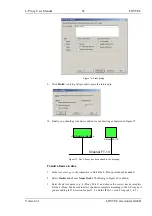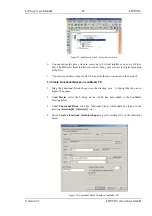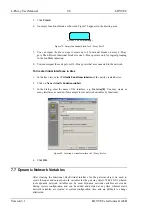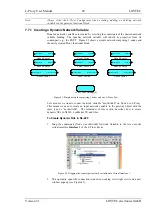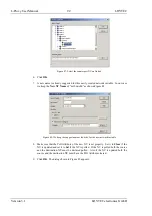
L-Proxy User Manual
77
LOYTEC
Version 3.1
LOYTEC electronics GmbH
After all ports have been configured the engineer who is responsible for creating the
internal connections opens the Configurator software on one of his L-Proxy ports. Then he
must load the port interface definition files (see Section 7.9.12). When the interface
configurations have been loaded the connections can be created (see Section 7.11).
After the connections have been created, download the configuration when the L-Proxy is
connected to the network using the configuration software (see Section 7.9.11). It is
recommended to save the complete configuration to a disk file for being able to replace an
L-Proxy in the network.
Note, that once the static NV interface is complete and all bindings are in place it is not
recommended to change that interface. To add NVs to such a configuration it is
recommended using dynamic NVs. Please refer to Section 7.4.5 on how to extend an
existing configuration with LNS.
7.4.4 Configure without LNS using Static NVs
Without LNS the L-Proxy can be configured using static NVs. This is beneficial, if
network variables shall use bindings, but the installer uses a network management tool,
which is not based on LNS 3.x. The basic work flow is depicted in Figure 65. This
workflow requires the advanced operation mode. To configure an L-Proxy without LNS,
an IP connection must be available.
The L-Proxy Configurator software needs to be started in stand-alone mode (see Section
7.9.2). Then the user needs to configure the static NVs for the desired L-Proxy port (see
Section 7.9.9). After all static NVs have been configured the port interface definition file
for the L-Proxy port needs to be exported (see Section 7.9.12).
For network management tools, which do not support the ECS (enhanced command set)
network management commands, the legacy network management mode must be
configured (see Section 7.9.14). Please contact the tool’s vendor for information whether
ECS is supported or not.
Then also export the static NV interface as a XIF file (see Section 7.9.13). The XIF file has
to be used in the non-LNS tool to create a device for the L-Proxy. Using that device, the
integrator can create the bindings in that tool. Please refer to the documentation of the
network management tool on how to create devices from a XIF file and bind network
variables.
Close the Configurator software and repeat this procedure for all other L-Proxy ports. Note,
that the other L-Proxy ports may be added to different domains by different engineers. If
multiple engineers are working on a project they need to designate one engineer, who is
responsible for creating the internal connections. In the end, a set of port definition files
must be available to that engineer.
After all ports have been configured the engineer who is responsible for creating the
internal connections opens the L-Proxy Configurator stand-alone. Then he must load the
port interface definition files (see Section 7.9.12). When the interface configurations have
been loaded the connections can be created (see Section 7.11).
After the connections have been created, the complete configuration can be saved. Before
downloading the new L-Proxy configuration, the user must connect the configuration
software to the L-Proxy via the FTP connection button (see Section 7.9.2). After the
configuration has been downloaded to the L-Proxy the integrators need to commission the
L-Proxy devices in their network management tools. It is recommended to save the entire
configuration to a disk file for being able to replace an L-Proxy in the network.
Note, that once the static NV interface is complete and all bindings are in place it is not
recommended to change that interface. Since the XIF files change the device may have to
be deleted in the respective network management tool and created again from the new XIF
Summary of Contents for L-Proxy
Page 1: ...L Proxy CEA 709 Gateway User Manual LOYTEC electronics GmbH ...
Page 10: ......























